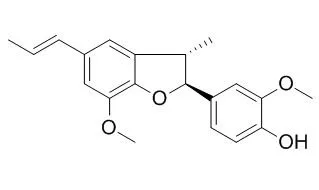| In vitro: |
| Planta Med. 2011 Oct;77(15):1712-7. | | Metabolism of the lignan dehydrodiisoeugenol in rats.[Pubmed: 21544774] | Dehydrodiisoeugenol (DDIE), a major active lignan from the seed and aril of the fruit of Myristica fragrans Houtt., functions as a potential anti-inflammatory agent by inhibiting lipopolysaccharide-stimulated nuclear factor kappa B activation and cyclooxygenase-2 expression in macrophages. However, the metabolism of DDIE remains unknown.
METHODS AND RESULTS:
This report describes the metabolic fate of DDIE in liver microsomes, urine, and feces of rats treated with DDIE. DDIE metabolites were isolated by sequential column chromatography and high-performance liquid chromatography from liver microsomes incubations, urine, and feces. Nine metabolites ( M-1 to M-9), including 5 new metabolites, were determined spectroscopically using ultra-violet (UV), mass spectrometry (MS), nuclear magnetic resonance (NMR), and circular dichroism (CD). Analysis of the isolated metabolites showed that DDIE undergoes four major pathways of metabolism in the rat: oxidation (including hydroxylation, hydroformylation, and acetylation), demethylation, ring-opening, and dehydrogenation. In contrast to the metabolites from liver microsomes, the major metabolites In vivo were generated from DDIE by multiple metabolic reactions.
CONCLUSIONS:
Given these results, we describe a metabolic pathway for DDIE in the rat that gives insight into the metabolism of DDIE and the mechanism of DDIE bioactivity in humans. | | J Pharm Biomed Anal . 2017 Oct 25;145:725-733. | | Metabolic profiling of dehydrodiisoeugenol using xenobiotic metabolomics[Pubmed: 28806569] | | Abstract
Dehydrodiisoeugenol (DDIE), a representative and major benzofuran-type neolignan in Myristica fragrans Houtt., shows anti-inflammatory and anti-bacterial actions. In order to better understand its pharmacological properties, xenobiotic metabolomics was used to determine the metabolic map of DDIE and its influence on endogenous metabolites. Total thirteen metabolites of DDIE were identified through in vivo and in vitro metabolism, and seven of them were reported for the first time in the present study. The identity of DDIE metabolites was achieved by comparison of the MS/MS fragmentation pattern with DDIE using ultra-performance chromatography electrospray ionization quadrupole time-of-flight mass spectrometry (UPLC-ESI- QTOFMS). Demethylation and ring-opening reaction were the major metabolic pathways for in vivo metabolism of DDIE. Recombinant cytochrome P450s (CYPs) screening revealed that CYP1A1 is a primary enzyme contributing to the formation of metabolites D1-D4. More importantly, the levels of two endogenous metabolites 2,8-dihydroxyquinoline and its glucuronide were significantly elevated in mouse urine after DDIE exposure, which explains in part its modulatory effects on gut microbiota. Taken together, these data contribute to the understanding of the disposition and pharmacological activities of DDIE in vivo.
Keywords: Dehydrodiisoeugenol; Metabolic profiling; UPLC-ESI-QTOFMS; Xenobiotic metabolomics. |
|






 Cell. 2018 Jan 11;172(1-2):249-261.e12. doi: 10.1016/j.cell.2017.12.019.IF=36.216(2019)
Cell. 2018 Jan 11;172(1-2):249-261.e12. doi: 10.1016/j.cell.2017.12.019.IF=36.216(2019) Cell Metab. 2020 Mar 3;31(3):534-548.e5. doi: 10.1016/j.cmet.2020.01.002.IF=22.415(2019)
Cell Metab. 2020 Mar 3;31(3):534-548.e5. doi: 10.1016/j.cmet.2020.01.002.IF=22.415(2019) Mol Cell. 2017 Nov 16;68(4):673-685.e6. doi: 10.1016/j.molcel.2017.10.022.IF=14.548(2019)
Mol Cell. 2017 Nov 16;68(4):673-685.e6. doi: 10.1016/j.molcel.2017.10.022.IF=14.548(2019)